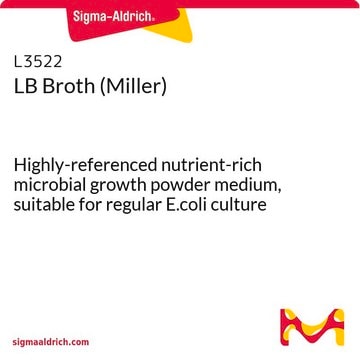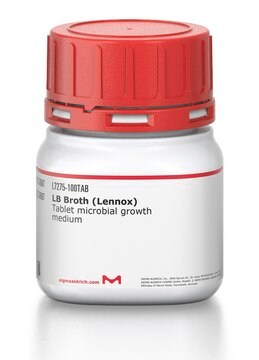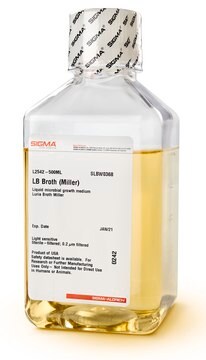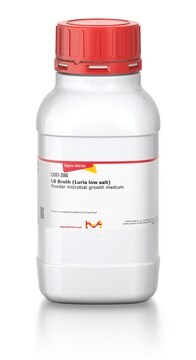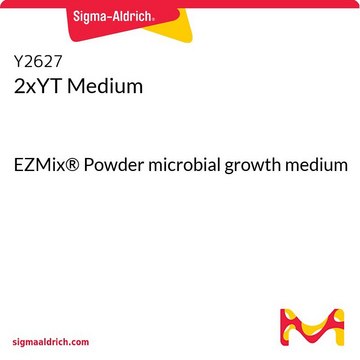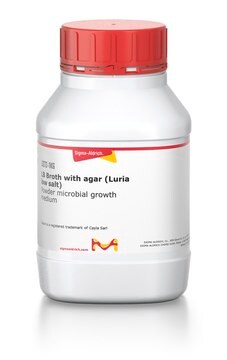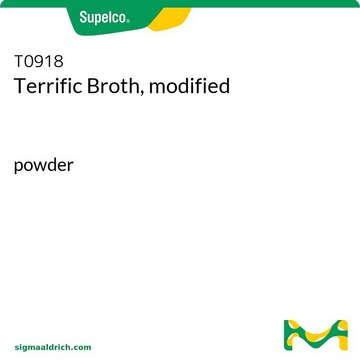おすすめの製品
グレード
for molecular biology
品質水準
詳細
quick-dissolve, dust-free formulation
無菌性
non-sterile
フォーム
powder
テクニック
microbiological culture: suitable
pH
6.8-7.2(2.5% solution)
アプリケーション
agriculture
food and beverages
microbiology
保管温度
room temp
適合性
nonselective for Escherichia coli
nonselective for coliforms
詳細
レノックスLB は大腸菌の培養に用いられる高度に参照される微生物の増殖培地です。この栄養豊富な微生物の培養液は、低塩製剤中にペプチド、アミノ酸、水溶性ビタミンおよび炭水化物を含みます。
アプリケーション
クローニング、DNAプラスミド産生および組換えタンパク質の産生用大腸菌株の非選択的培養に適しています。ゼオシンのような低塩条件を必要とするものを含み、適切な抗生物質を添加した場合の選択的培養にも適しています®。
特徴および利点
Lennox LB EZMix粉末は以下を提供します:
- 安全に取扱いでき迅速に混合できる粒状で粉塵が無いフォーマット
- 秤量の必要がない便利な少量包装
- より大きいパッケージサイズを用いる容易なスケールアップ
- 標準処方
構成
*製品サイズの一部は、液量で示されています。この製品は粉末であり、液量サイズは最終的な溶解後の体積を示しています。
10 g/L トリプトン
5 g/L 酵母抽出物
5 g/L NaCl
0.6 g/L 不活性バインダー(EZMix処方のみ)
10 g/L トリプトン
5 g/L 酵母抽出物
5 g/L NaCl
0.6 g/L 不活性バインダー(EZMix処方のみ)
調製ノート
1.蒸留水1 Lに20.6 gを懸濁させます。
2.121°Cで15分間オートクレーブ処理します。
Lennox Lブロスの調製法。グルコース1 gを加えた後、上記の調製指示に従います。
Enquist and Sternberg培地の調整法。オートクレーブ処理後、滅菌1 M硫酸マグネシウムを無菌的に10 mL添加します。
2.121°Cで15分間オートクレーブ処理します。
Lennox Lブロスの調製法。グルコース1 gを加えた後、上記の調製指示に従います。
Enquist and Sternberg培地の調整法。オートクレーブ処理後、滅菌1 M硫酸マグネシウムを無菌的に10 mL添加します。
再構成
20.6 gの粉末を1 Lの水に懸濁して撹拌してください。121°Cで15分間オートクレーブ滅菌します。抗生物質など(必要な場合)を添加する前に冷却してください。
法的情報
Zeocin is a registered trademark of Cayla Sarl
関連製品
製品番号
詳細
価格
保管分類コード
11 - Combustible Solids
WGK
WGK 2
引火点(°F)
Not applicable
引火点(℃)
Not applicable
適用法令
試験研究用途を考慮した関連法令を主に挙げております。化学物質以外については、一部の情報のみ提供しています。 製品を安全かつ合法的に使用することは、使用者の義務です。最新情報により修正される場合があります。WEBの反映には時間を要することがあるため、適宜SDSをご参照ください。
Jan Code
L7658-VAR:
L7658-500ML:
L7658-6X500ML:
L7658-5L:
L7658-500ML-C:
L7658-1KG:
L7658-BULK:
L7658-1KG-C:
L7658-5KG:
L7658-2X5L:
この製品を見ている人はこちらもチェック
Jennifer White et al.
Protein science : a publication of the Protein Society, 13(9), 2406-2415 (2004-08-24)
Decay-accelerating factor (DAF, CD55) is a glycophosphatidyl inositol-anchored glycoprotein that regulates the activity of C3 and C5 convertases. In addition to understanding the mechanism of complement inhibition by DAF through structural studies, there is also an interest in the possible
Katherine A Kantardjieff et al.
Acta crystallographica. Section D, Biological crystallography, 60(Pt 5), 895-902 (2004-04-23)
The Mycobacterium tuberculosis rmlC gene encodes dTDP-4-keto-6-deoxyglucose epimerase, the third enzyme in the M. tuberculosis dTDP-L-rhamnose pathway which is essential for mycobacterial cell-wall synthesis. Because it is structurally unique, highly substrate-specific and does not require a cofactor, RmlC is considered
Michael C Konopka et al.
Journal of bacteriology, 188(17), 6115-6123 (2006-08-23)
The first in vivo measurements of a protein diffusion coefficient versus cytoplasmic biopolymer volume fraction are presented. Fluorescence recovery after photobleaching yields the effective diffusion coefficient on a 1-mum-length scale of green fluorescent protein within the cytoplasm of Escherichia coli
Alexis Kaushansky et al.
Nature protocols, 5(4), 773-790 (2010-04-03)
Protein microarrays provide an efficient way to identify and quantify protein-protein interactions in high throughput. One drawback of this technique is that proteins show a broad range of physicochemical properties and are often difficult to produce recombinantly. To circumvent these
Feng Xu et al.
PloS one, 6(4), e19344-e19344 (2011-05-10)
Decellularization and cellularization of organs have emerged as disruptive methods in tissue engineering and regenerative medicine. Porous hydrogel scaffolds have widespread applications in tissue engineering, regenerative medicine and drug discovery as viable tissue mimics. However, the existing hydrogel fabrication techniques
ライフサイエンス、有機合成、材料科学、クロマトグラフィー、分析など、あらゆる分野の研究に経験のあるメンバーがおります。.
製品に関するお問い合わせはこちら(テクニカルサービス)
